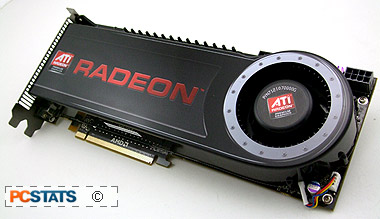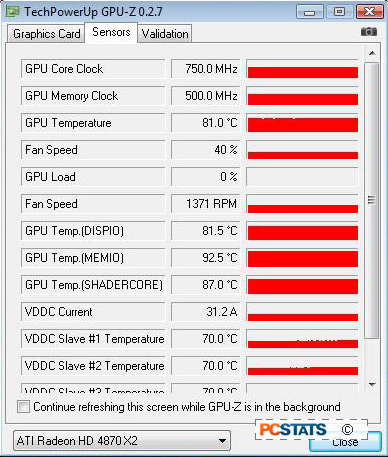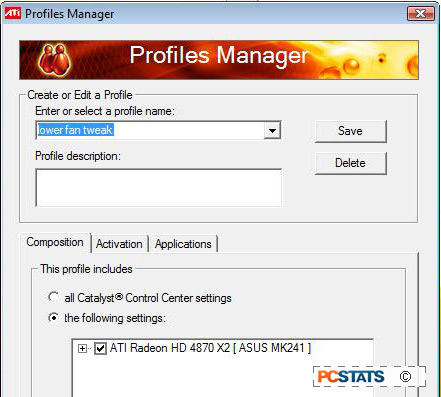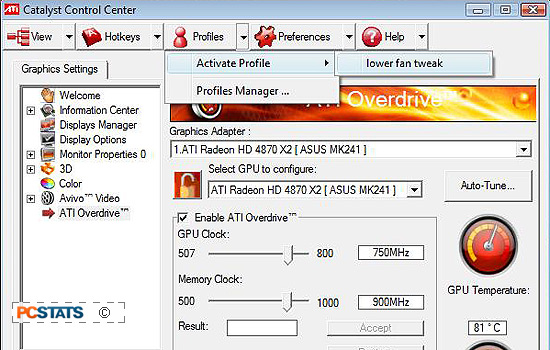 |
| Overclocking Results: |
|
|
The
Palit HD 4870 X2 videocard uses ATI's stock memory and GPU timings
of 900Mhz (1800Mhz DDR) and 750Mhz respectively, so PCSTATS was
hoping to get some good overclocking results out of it. Were we
successful? Read on...
As usual, we will start by increasing the GPU speed in 25Mhz
increments, followed by the memory in 50Mhz blocks We take note of
any stability problems or the appearance of artifacts, and then list
the maximum stable and artifact-free overclocked speed the video card
can attain.
The Palit HD 4870 X2's twin R770
GPUs successfully achieved 775Mhz and 800Mhz without any sign of
artifacts or instability. Sadly, we were not able to achieve a stable
overclock beyond this point. Possibly the complicated nature of the
internal connection between the card's two GPUs is limiting the
overclocking potential here?
 The memory was next, and proved
a bit more successful. We easily cruised past the 950Mhz and 1GHz
marks, and also managed to run the card stably at 1050MHz and 1.1GHz,
before the appearance of video artifacts curtailed our fun. The Palit
HD 4870 X2 topped out at a respectable 1.1GHz (2.2GHz DDR) memory
speed, proving that whatever is limiting the GPU's overclocking
potential does not bother the memory side of things.
The memory was next, and proved
a bit more successful. We easily cruised past the 950Mhz and 1GHz
marks, and also managed to run the card stably at 1050MHz and 1.1GHz,
before the appearance of video artifacts curtailed our fun. The Palit
HD 4870 X2 topped out at a respectable 1.1GHz (2.2GHz DDR) memory
speed, proving that whatever is limiting the GPU's overclocking
potential does not bother the memory side of things.
The Palit HD 4870 X2 is not going to set
the world on fire with its overclocking ability just yet, but that's
not really the advertised purpose of the card. The Radeon HD 4870 X2
chipset is designed to provide a high-end single card gaming
experience out of the box, and next up we will see if that's what it
truly does.
Tweaking Fan Speed for Lower Temperatures
After a few rounds of benchmarking with the Palit HD4870X2, it quite
literally became too hot to touch. Curiously, in spite of
the burn-your-fingers-heatsink-temperature, the videocard's 60mm fan
remained relatively slow and quiet throughout testing, even while
running an intensive set of Crysis benchmarks at 1920x1200!! It's a safe bet
the videocard's twin GPUs were generating heat like fiery furnace, and sure
enough GPU temperatures were hovering around the 80-90C mark. The memory
heatsink along the top of the card was an
astounding 60C.... far from ideal conditions regardless of how quiet
the videocard was operating.

Why the heatsink's fan wasn't kicking up the RPM to deal with the heat is a
question only AMD can address, drivers always seems to its weakest point.
Luckily, there is a quick software hack you can do to dramatically lower
GPU and memory temperatures. Credit is due to Guru3d for
coming up with this one, and you'll find that it
applies to just about any ATI Radeon videocard on the market now.

First ensure that Catalyst 8.8 drivers are installed (or newer), then open up
Catalyst Control Center and go to > ATI Overdrive > and enable
overdrive by clicking on the little padlock icon. Next, click on Profiles >
Profile Manager and create a new profile called "Lower Fan Tweak". Check "all
catalyst control center settings" and click Save. Next, within Windows Vista go
to:
C:\Users\*your ID*\Appdata\Local\ATI\ACE\Profiles\Lower Fan
Tweak.xml
Right click on the file and select "edit", we need to
edit some parameters in the XML.
Find "FanSpeedAlgorithm" and change value="Automatic" to value="Manual". The
term "manual" is case sensitive, so spell it Manual.
Next, find
"FanSpeedPercentTarget_1" and change to your desired fan speed percentage, value="100" for full fan
speed, value="50" for half, you get the idea. The number may be 23, or
some other integer.
Note that if you change the values for FanSpeedPercentTarget_0, this won't
work on the dual GPU HD 4870 X2 videocard - that parameter (the "_0"
parameter) is for the single GPU Radeon HD 4870 videocards. I made this mistake
the first time and it took me a couple minutes to figure out why the fan speed
didn't change at all.
Save the XML file you've just edited. Back in the Catalyst Control
Center load up the "Lower Fan Tweak" profile. You should immediately
notice the fan on the Palit HD 4870 X2 speed up to 100% duty.

For our testing PCSTATS simply set the value to 100, which results in a
pretty vigorous whooshing noise. Within a few minutes the GPU temperature fell
from 82C to 46C, and fan speed had risen from 1300RPM (23%)
to 4700RPM (100%). If you play around with the values you'll find a happy medium
to achieve low temps and moderate noise levels.
